The Importance of Adjusting TPN Based on Patient-Specific Metabolism
Understanding the Role of Personalized TPN in Clinical Care
Total Parenteral Nutrition (TPN) is a vital medical intervention for patients unable to meet their nutritional needs through oral or enteral routes. Its success hinges on precise adjustments tailored to individual metabolic profiles, ensuring optimal recovery while minimizing adverse effects. This article explores the principles, practices, and implications of customizing TPN based on patient-specific metabolic conditions, emphasizing the importance of vigilant monitoring, technological advancements, and interdisciplinary collaboration.
Defining Personalized TPN and Its Significance
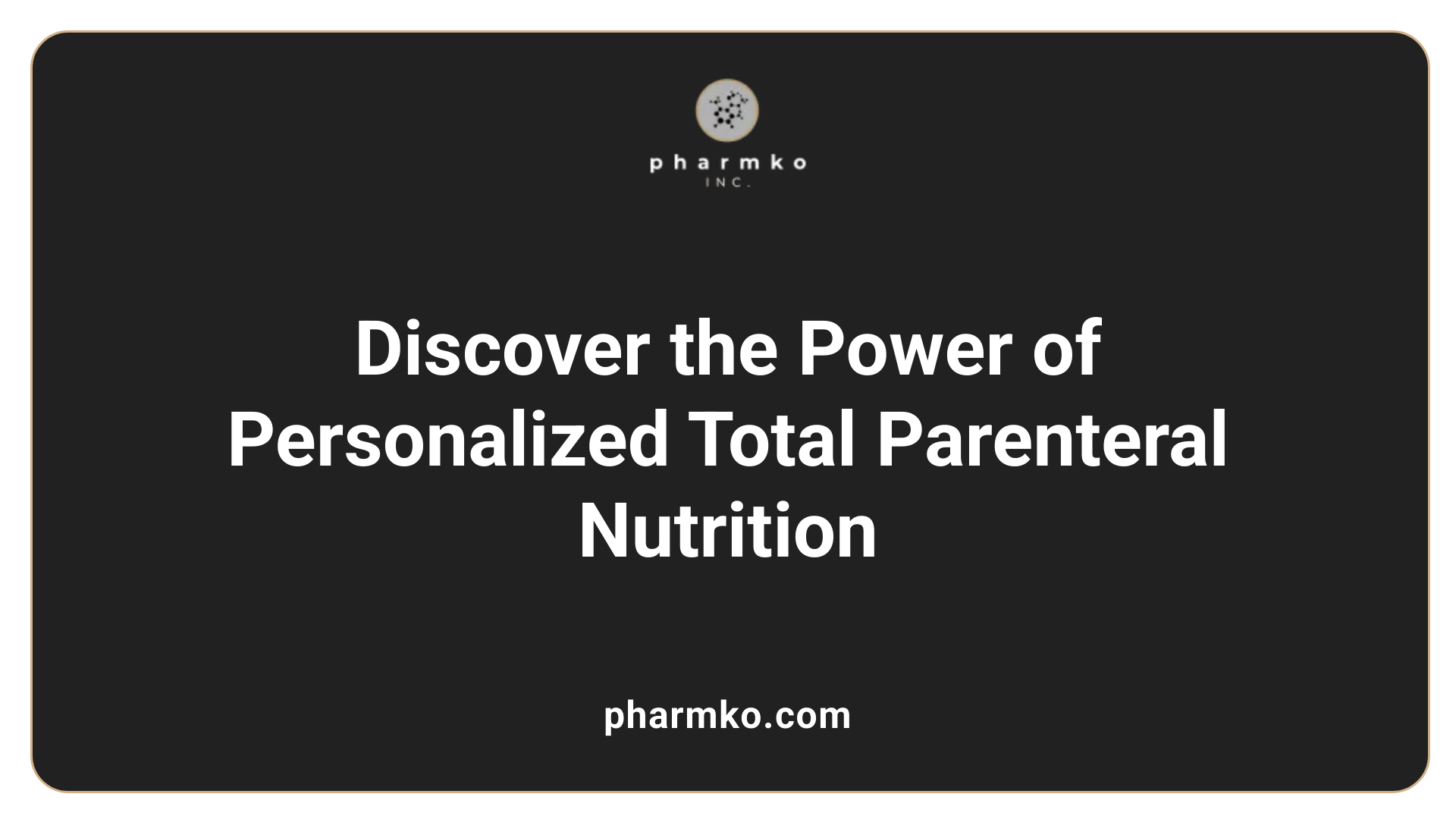
What is personalized Total Parenteral Nutrition (TPN) and why is individualization important?
Personalized TPN refers to the tailored formulation and delivery of nutrients directly into a patient's bloodstream, designed specifically to meet their unique metabolic needs, medical conditions, and response to therapy. Instead of a one-size-fits-all approach, this method considers factors like age, weight, disease state, organ function, and metabolic rate.
Individualizing TPN is vital for optimizing patient outcomes. It ensures that each patient receives the right balance of macronutrients—such as carbohydrates, proteins, and lipids—and micronutrients like vitamins, minerals, and trace elements. Proper adjustment helps prevent complications such as electrolyte imbalances, infections, hyperglycemia, or overfeeding.
To achieve precise customization, clinicians often use advanced tools such as indirect calorimetry, which measures resting energy expenditure, or biomarker monitoring, including serum electrolytes and liver function tests. These techniques help assess the patient's current metabolic state and guide necessary adjustments.
Emerging technologies, including AI-driven prescription models like TPN2.0, further enhance the accuracy and safety of individualized nutrition plans. Combining technology with clinical expertise allows healthcare providers to design dynamic TPN regimens that evolve with the patient’s condition.
In summary, personalized TPN supports recovery, minimizes risks, and contributes to better long-term health. Especially for critically ill or chronic patients, this approach ensures nutrition is used as a therapeutic tool tailored to their specific needs and responses.
Core Components of TPN and Their Personalization
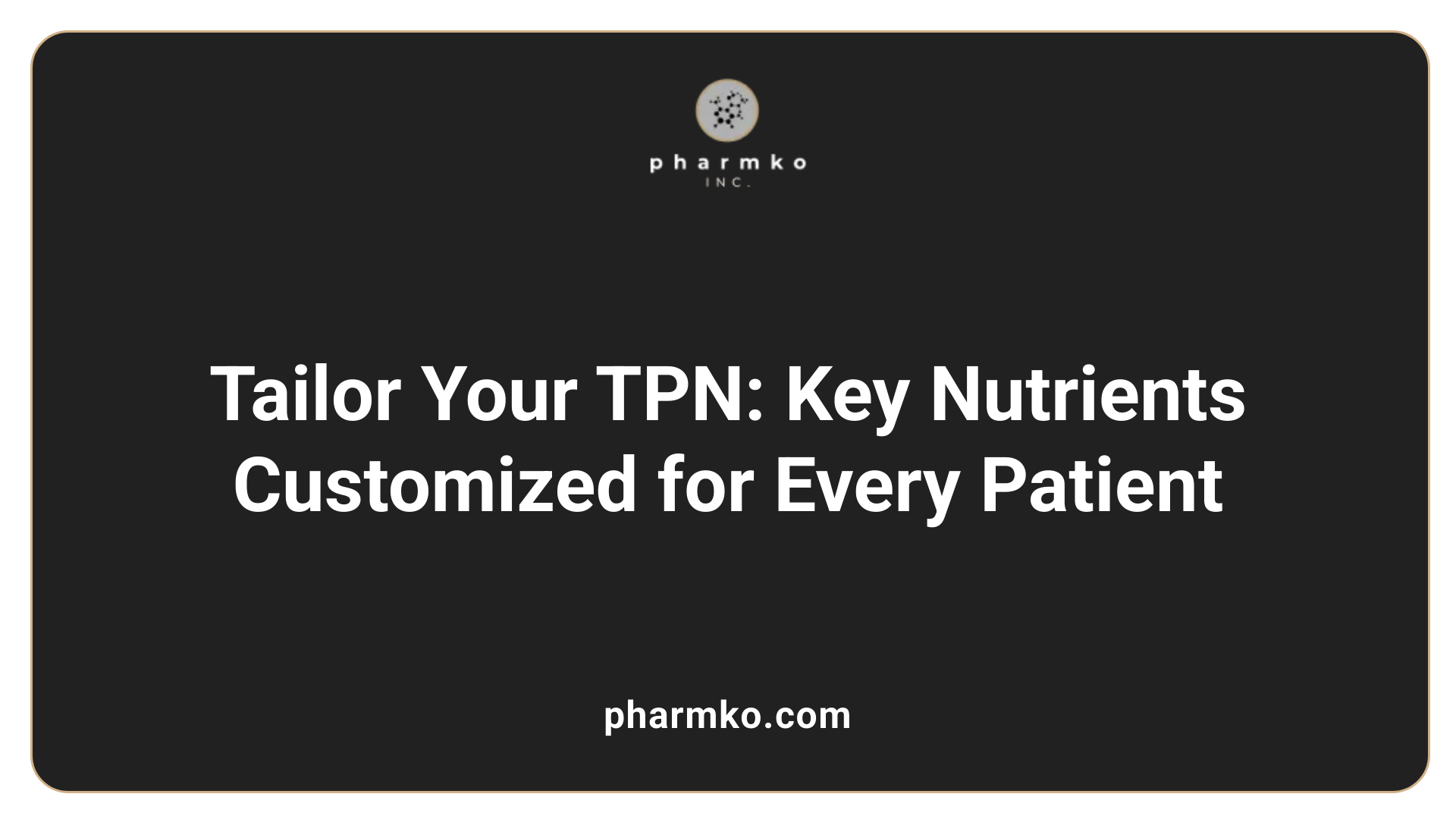
What are key nutritional components in TPN and how are they personalized?
Total parenteral nutrition (TPN) delivers essential nutrients directly into the bloodstream when the gastrointestinal tract cannot be used. Its formulations comprise macronutrients such as carbohydrates (usually dextrose), proteins (amino acids), and lipids (fats). Alongside these, micronutrients including electrolytes, vitamins, and trace elements are added to support cellular metabolism, immune function, and overall health.
Personalizing TPN involves careful adjustment of each component based on individual patient factors. Healthcare providers assess factors like weight, age, medical condition, and metabolic status through clinical evaluations and laboratory tests. For instance, surgical or critically ill patients may require higher protein and calorie intake to support tissue repair and recovery.
Electrolyte levels are fine-tuned according to lab results to prevent imbalances that could cause complications like arrhythmias or muscle weakness. Similarly, renal impairment necessitates electrolyte restriction and fluid management adjustments. Regular monitoring of serum electrolytes, liver function, and metabolic markers guides ongoing modifications.
By tailoring TPN components, clinicians optimize nutritional support, promote metabolic stability, and minimize risks such as hyperglycemia, electrolyte abnormalities, or liver dysfunction. This dynamic adjustment process ensures that each patient receives a safe, effective, and individualized nutritional therapy.
More Information
For detailed clinical guidelines on customizing TPN formulations, searching "TPN formulation customization clinical guidelines" can provide access to current protocols and evidence-based practices.
Monitoring Parameters to Guide TPN Adjustments
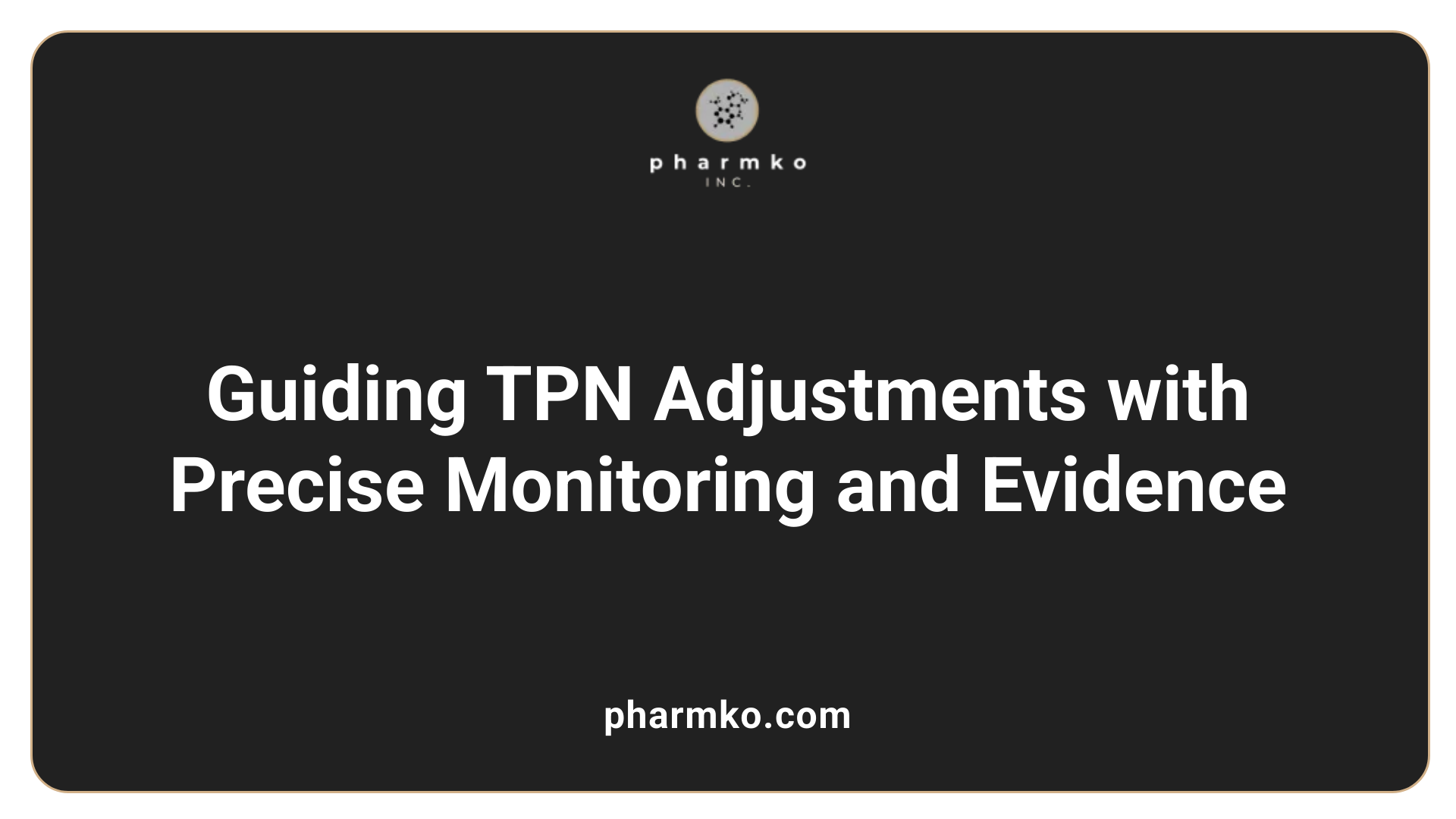
How can monitoring and scientific evidence guide the adjustment of TPN for individual patients?
Effective management of total parenteral nutrition (TPN) relies heavily on careful, ongoing assessment of various physiological parameters. Regular monitoring of serum electrolytes—such as magnesium, potassium, and phosphate—is essential to prevent and correct imbalances that can lead to serious complications like cardiac arrhythmias or neuromuscular issues.
Liver function tests (LFTs), including ALT, AST, bilirubin, and alkaline phosphatase, provide insights into hepatic tolerance and early signs of TPN-induced liver dysfunction, such as cholestasis or steatosis. Tracking these markers allows clinicians to modify lipid components or adjust infusion rates to minimize hepatic injury.
Metabolic markers like blood glucose, triglycerides, and acid-base balance give immediate feedback on the patient’s metabolic response. Hyperglycemia may indicate the need to reduce dextrose infusion or adjust insulin therapy, while elevated triglycerides might necessitate lipid adjustment.
Nutritional markers such as prealbumin, transferrin, and CRP help evaluate protein status and inflammatory response, guiding the refinement of amino acid and micronutrient dosing. Emerging technologies, including indirect calorimetry, estimate resting energy expenditure more accurately, helping tailor caloric and protein intake to meet individual energy demands.
This combination of scientific data supports personalized modifications to TPN formulations. When clinicians respond swiftly to lab findings and clinical signs, they can prevent complications like refeeding syndrome, infections, or metabolic derangements. Thus, continuous, evidence-based monitoring ensures that TPN remains optimized for each patient's unique needs, promoting better outcomes and reducing adverse effects.
Adjusting TPN in Critical and Renal Patients
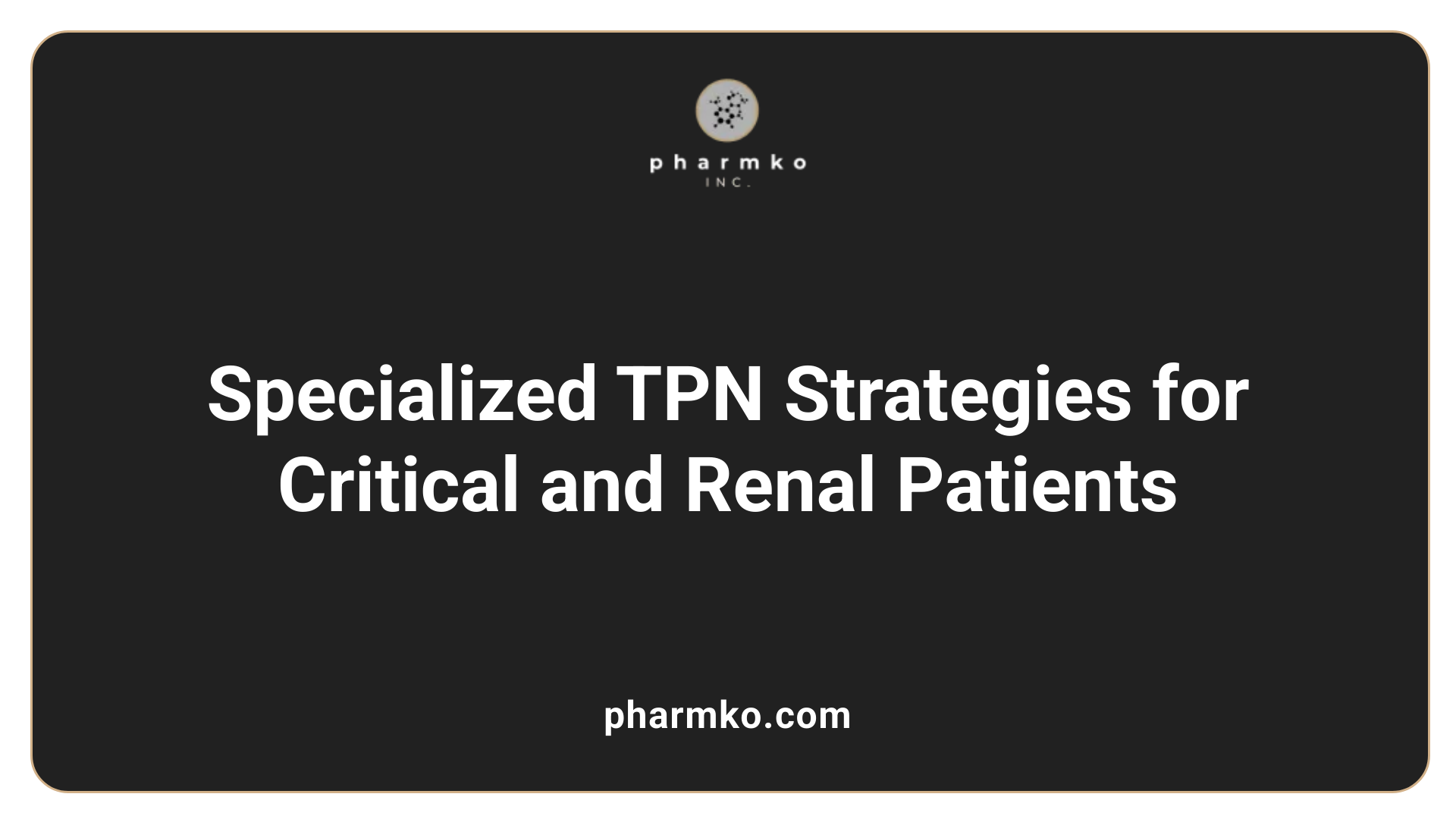
What are the considerations when formulating TPN for patients with critical illness or renal impairment?
When providing total parenteral nutrition (TPN) to patients experiencing critical illness or renal failure, careful customization of the nutrient formulation is essential. In critically ill patients, the metabolic demands are often increased, requiring higher amounts of macronutrients such as proteins and calories to support tissue repair and immune function. However, these needs must be balanced to avoid overfeeding, which can lead to complications like hyperglycemia or fatty liver.
For patients with renal impairment, the formulation must be adjusted cautiously. Electrolyte content, including sodium, potassium, magnesium, and phosphorus, should be carefully monitored and tailored to prevent uremia, electrolyte imbalances, or volume overload. Fluid restrictions are particularly important in renal failure to reduce the risk of edema and hypertension.
Ongoing monitoring includes checking serum levels of electrolytes, renal function markers such as serum creatinine, and glomerular filtration rate (GFR). The carbohydrate infusion rate should be initially limited, typically to less than 4-5 mg/kg/min, to prevent hyperglycemia and minimize hepatic steatosis. Adjustments are made according to the patient’s blood glucose tolerance and metabolic response.
Overall, interdisciplinary collaboration involving physicians, pharmacists, and nutrition specialists ensures that TPN is continuously optimized. This personalized approach helps prevent secondary kidney damage, metabolic derangements, and supports the patient’s recovery or stabilization.
Special Pediatric and Neonatal TPN Considerations

Why is individualized TPN especially important in neonatal care?
Neonates, particularly preterm infants, have distinct metabolic needs and immature organ systems that make standardized TPN approaches insufficient. Because their livers, kidneys, and gastrointestinal tracts are still developing, they require precise nutrient formulations tailored to their unique requirements. Properly individualized TPN can help promote optimal growth, support organ development, and prevent complications.
Early nutritional intervention with tailored TPN has demonstrated benefits. Starting with appropriate amino acid doses can be well tolerated and supports early growth. For example, higher initial protein levels may be beneficial in neonates to address increased metabolic demands during critical early phases.
Monitoring plays a vital role in this process. Parameters such as prealbumin levels, body weight, and laboratory markers like electrolytes and liver function help guide ongoing adjustments. This ensures that nutritional support remains aligned with the infant’s actual needs, promoting safety and growth.
Furthermore, careful attention to issues like refeeding syndrome, electrolyte imbalances, and lipid intolerance is crucial. Neonates are particularly vulnerable to these complications due to their fragile physiology. Tailoring TPN helps mitigate these risks, fostering better health outcomes.
How should TPN be tailored for neonatal growth?
Adjustments in TPN formulations should consider gestational age, birth weight, current weight, and clinical condition. Nutrient goals are higher for preterm and very low birth weight infants to support rapid growth and neurodevelopment.
Monitoring is continuous and involves regular assessment of labs and growth metrics. As neonatal health improves, TPN can be gradually tapered and transitioned to enteral nutrition when feasible.
This careful, individualized approach underscores the importance of a multidisciplinary team—neonatologists, nutritionists, and pharmacists—working together to optimize TPN therapy in these vulnerable patients.
Implications of TPN on Long-Term Outcomes and Complications
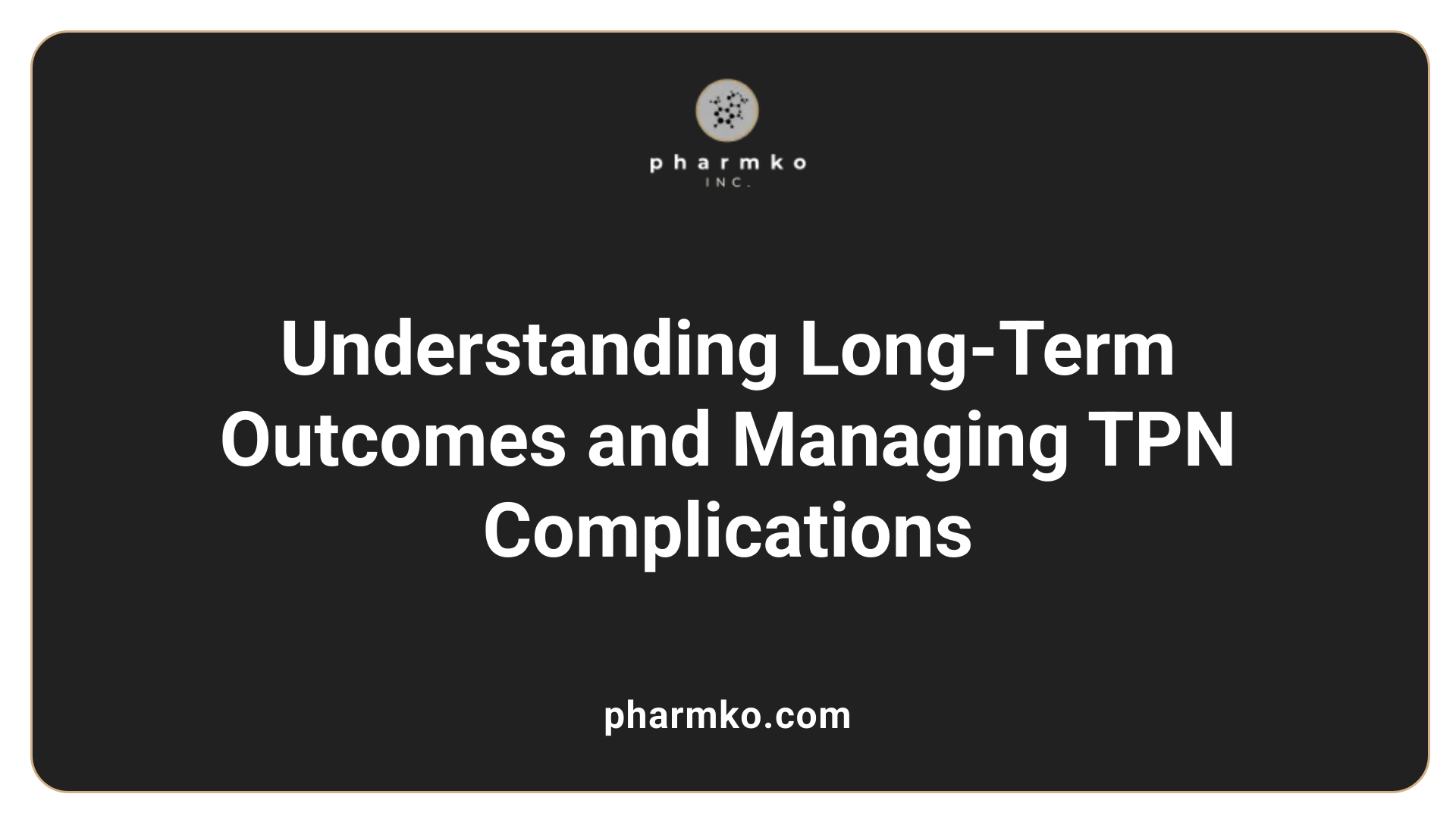
What are common metabolic complications associated with TPN use?
Parenteral nutrition (PN) can lead to several metabolic issues if not carefully monitored and tailored to individual needs. Hyperglycemia is one of the most common problems, occurring in up to half of TPN patients, especially those with insulin resistance or diabetes. It results from the high glucose content in the infusion and can cause further complications if unmanaged.
Electrolyte disturbances are also prevalent, with hypophosphatemia, hypokalemia, and hypomagnesemia being frequently observed. These imbalances are often linked to refeeding syndrome, a condition that can develop rapidly in malnourished individuals when nutrients are reintroduced too quickly. Managing these electrolytes closely is vital for preventing cardiac and neurological complications.
Lipid metabolism abnormalities, such as hypertriglyceridemia affecting approximately 25–50% of patients, pose another concern. Elevated triglyceride levels may increase the risk of pancreatitis and require regular monitoring of serum triglycerides.
Long-term TPN can impact liver health, often leading to fatty liver, cholestasis, or non-alcoholic fatty liver disease. These hepatic issues are frequently associated with excessive glucose and lipid infusion, emphasizing the need for appropriate formulation adjustments.
Refeeding syndrome remains a serious concern, particularly in severely malnourished patients. It involves electrolyte shifts, notably of phosphate, potassium, and magnesium, which can compromise cardiac function. Preventing refeeding syndrome necessitates gradual nutritional repletion and vigilant electrolyte monitoring.
In summary, common metabolic complications of TPN include hyperglycemia, electrolyte imbalances, hypertriglyceridemia, and hepatic dysfunction, all requiring proactive management to improve patient outcomes.
The Role of Advanced Technologies in TPN Personalization
How can monitoring and scientific evidence guide the adjustment of TPN for individual patients?
Personalized Total Parenteral Nutrition (TPN) relies heavily on monitoring and scientific evidence to optimize patient outcomes. Regular testing of blood parameters such as serum electrolytes, liver function, and metabolic markers helps clinicians detect early signs of imbalances or complications like hyperglycemia or liver dysfunction.
A crucial tool in tailoring TPN is indirect calorimetry, which accurately measures a patient’s resting energy expenditure. This data allows healthcare providers to adjust caloric and protein intake precisely, avoiding overfeeding or underfeeding. Fine-tuning these components reduces risks like refeeding syndrome and metabolic disturbances.
In addition, emerging technologies such as AI-driven prescription models—sometimes referred to as TPN 2.0—are being developed. These systems analyze patient data, including laboratory results and metabolic trends, to recommend real-time adjustments to TPN formulations. These advancements help clinicians rapidly respond to changes in the patient’s condition.
Furthermore, innovative monitoring tools, such as metabolomic analyses and advanced bedside sensors, provide continuous insight into the patient’s metabolic state. This integration of technology and evidence-based data supports a more dynamic, individualized approach.
Overall, the combination of scientific evidence and technological innovations enables ongoing, tailored modifications to TPN. This tailored approach maximizes nutritional benefits, minimizes adverse effects, and enhances recovery, especially in critically ill or complex cases.
Nursing and Interdisciplinary Roles in TPN Management
What are key nursing interventions for patients receiving TPN?
Nursing care is integral to the safe and effective administration of Total Parenteral Nutrition (TPN). One of the fundamental practices involves maintaining strict aseptic technique during the preparation and infusion of TPN to minimize the risk of infections, which can be life-threatening.
Prior to administration, nurses must verify that the TPN formulation is correct, ensuring it matches the physician’s orders in composition and volume. Connecting the infusion to a central venous catheter requires careful asepsis, and the use of infusion pumps helps deliver the solution at a consistent rate.
Continuous monitoring of blood glucose levels is crucial to detect hyperglycemia early, especially during the initial phase of TPN therapy. Regular assessments of serum electrolytes, liver function tests, and fluid status help identify imbalances or early signs of metabolic complications.
Nurses should vigilantly observe the infusion site for signs of infection, thrombosis, or local inflammation. Any signs of catheter site infection or systemic infection necessitate prompt intervention, which could include antibiotic therapy or catheter removal.
Fluid overload and liver dysfunction are other potential risks. Accurate documentation of all aspects of TPN administration—including infusion rates, patient responses, and laboratory results—is essential for ongoing management.
Proper use of infusion devices, inspecting the solution for particulates or discoloration, and ensuring tubing patency through regular flushing are important steps. Collaboration with the healthcare team enables timely adjustments to the TPN regimen based on the patient’s changing metabolic needs.
More Information
Search query: nursing interventions TPN infection control
Effective patient care in TPN management relies on meticulous monitoring, aseptic techniques, and interdisciplinary teamwork, aiming to reduce complications and improve nutritional outcomes.
The Interdisciplinary Approach to Optimizing TPN Therapy
Effective management of total parenteral nutrition (TPN) requires a collaborative approach among various healthcare professionals, with pharmacists playing a vital role. Pharmacists assess each patient's unique nutritional needs, design tailored TPN formulations, and monitor for potential complications. Their expertise ensures that nutrient compositions—including macronutrients like carbohydrates, proteins, and lipids, as well as micronutrients such as vitamins, minerals, and trace elements—are precisely adjusted according to metabolic responses.
Nutrition support teams (NSTs), typically comprising physicians, dietitians, pharmacists, and nurses, develop individualized care plans that consider the patient’s clinical status, prognosis, and specific risk factors. These teams regularly evaluate laboratory results—such as serum electrolytes, liver function tests, and metabolic markers—and incorporate advanced assessments like indirect calorimetry to estimate resting energy expenditure. This evidence-based practice helps refine TPN prescriptions, preventing issues like hyperglycemia, electrolyte imbalances, and liver dysfunction.
Clinical guidelines advocate for continuous monitoring and timely adjustments of TPN components. Such guidelines recommend adjusting nutrient amounts based on real-time data, especially in critically ill or malnourished patients, to promote metabolic stability and healing. For example, if laboratory results reveal elevated triglycerides or abnormal liver enzymes, formulations are modified to mitigate these effects.
An interdisciplinary team approach ensures that decisions are comprehensive and patient-centered. Regular communication among team members facilitates quick responses to emerging issues, optimizing therapeutic outcomes. This structure not only reduces complications but also improves overall patient recovery, especially in complex cases like postoperative or oncologic nutrition.
Monitoring and scientific evidence form the backbone of TPN management. The use of techniques like indirect calorimetry provides precise energy requirements, guiding caloric and protein delivery tailored to individual metabolism. Routine lab tests alert clinicians to early signs of metabolic disturbances, prompting timely adjustments in TPN composition. This iterative process exemplifies how evidence-based practice and teamwork lead to safe, effective, and personalized nutrition therapy.
Ultimately, the success of TPN therapy depends on the seamless integration of clinical guidelines, technological advances, and multidisciplinary cooperation, all aimed at supporting patient recovery and preventing complications.
Enhancing Patient Outcomes Through Tailored Nutrition
Optimizing TPN through patient-specific adjustments is essential for improving clinical outcomes, reducing complications, and supporting recovery. Incorporating advanced monitoring tools, evidence-based practices, and interdisciplinary collaboration ensures that nutritional support is both effective and safe. As research and technology continue to evolve, so too will our capacity to deliver highly personalized nutrition therapy that meets the unique needs of each patient, ultimately advancing the quality of care worldwide.
References
- Total Parenteral Nutrition - StatPearls - NCBI Bookshelf
- Parenteral Nutrition Overview - PMC - PubMed Central
- Plasma metabolomics of early parenteral nutrition followed ... - Nature
- The Science Behind Total Parenteral Nutrition
- [PDF] Total Parenteral Nutrition in Patients with Kidney Disease
- Total parenteral nutrition for patients with gastrointestinal cancers
- Parenteral Nutrition - U.S. Pharmacist













